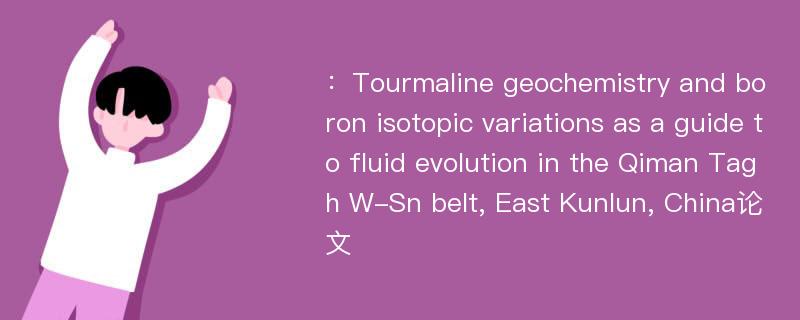
本文主要研究内容
作者(2019)在《Tourmaline geochemistry and boron isotopic variations as a guide to fluid evolution in the Qiman Tagh W-Sn belt, East Kunlun, China》一文中研究指出:The Qiman Tagh W-Sn belt lies in the westernmost section of the East Kunlun Orogen, NW China, and is associated with early Paleozoic monzogranites, tourmaline is present throughout this belt. In this paper we report chemical and boron isotopic compositions of tourmaline from wall rocks, monzogranites, and quartz veins within the belt, for studying the evolution of ore-forming fluids. Tourmaline crystals hosted in the monzogranite and wall rocks belong to the alkali group, while those hosted in quartz veins belong to both the alkali and X-site vacancy groups. Tourmaline in the walk rocks lies within the schorl-dravite series and becomes increasingly schorlitic in the monzogranite and quartz veins. Detrital tourmaline in the wall rocks is commonly both optically and chemically zoned,with cores being enriched in Mg compared with the rims. In the Al-Fe-Mg and Ca-Fe-Mg diagrams,tourmaline from the wall rocks plots in the fields of Al-saturated and Ca-poor metapelite, and extends into the field of Li-poor granites, while those from the monzogranite and quartz veins lie within the field of Li-poor granites. Compositional substitution is best represented by the MgFe-1, Al(NaR)-1, and AlO(Fe(OH))-1 exchange vectors. A wider range of δ11B values from -11.1‰ to -7.1‰ is observed in the wall-rock tourmaline crystals, the B isotopic values combining with elemental diagrams indicate a source of metasediments without marine evaporates for the wall rocks in the Qiman Tagh belt. The δ11B values of monzogranite-hosted tourmaline range from -10.7‰ and-9.2‰, corresponding to the continental crust sediments, and indicate a possible connection between the wall rocks and the monzogranite. The overlap in δ11B values between wall rocks and monzogranite implies that a transfer of δ11B values by anataxis with little isotopic fractionation between tourmaline and melts. Tourmaline crystals from quartz veins have δ11B values between -11.0‰ and-9.6‰, combining with the elemental diagrams and geological features, thus indicating a common granite-derived source for the quartz veins and little B isotopic fractionation occurred. Tourmalinite in the wall rocks was formed by metasomatism by a granite-derived hydrothermal fluid, as confirmed by the compositional and geological features.Therefore, we propose a single B-rich sedimentary source in the Qiman Tagh belt, and little boron isotopic fractionation occurred during systematic fluid evolution from the wall rocks, through monzogranite, to quartz veins and tourmalinite.
Abstract
The Qiman Tagh W-Sn belt lies in the westernmost section of the East Kunlun Orogen, NW China, and is associated with early Paleozoic monzogranites, tourmaline is present throughout this belt. In this paper we report chemical and boron isotopic compositions of tourmaline from wall rocks, monzogranites, and quartz veins within the belt, for studying the evolution of ore-forming fluids. Tourmaline crystals hosted in the monzogranite and wall rocks belong to the alkali group, while those hosted in quartz veins belong to both the alkali and X-site vacancy groups. Tourmaline in the walk rocks lies within the schorl-dravite series and becomes increasingly schorlitic in the monzogranite and quartz veins. Detrital tourmaline in the wall rocks is commonly both optically and chemically zoned,with cores being enriched in Mg compared with the rims. In the Al-Fe-Mg and Ca-Fe-Mg diagrams,tourmaline from the wall rocks plots in the fields of Al-saturated and Ca-poor metapelite, and extends into the field of Li-poor granites, while those from the monzogranite and quartz veins lie within the field of Li-poor granites. Compositional substitution is best represented by the MgFe-1, Al(NaR)-1, and AlO(Fe(OH))-1 exchange vectors. A wider range of δ11B values from -11.1‰ to -7.1‰ is observed in the wall-rock tourmaline crystals, the B isotopic values combining with elemental diagrams indicate a source of metasediments without marine evaporates for the wall rocks in the Qiman Tagh belt. The δ11B values of monzogranite-hosted tourmaline range from -10.7‰ and-9.2‰, corresponding to the continental crust sediments, and indicate a possible connection between the wall rocks and the monzogranite. The overlap in δ11B values between wall rocks and monzogranite implies that a transfer of δ11B values by anataxis with little isotopic fractionation between tourmaline and melts. Tourmaline crystals from quartz veins have δ11B values between -11.0‰ and-9.6‰, combining with the elemental diagrams and geological features, thus indicating a common granite-derived source for the quartz veins and little B isotopic fractionation occurred. Tourmalinite in the wall rocks was formed by metasomatism by a granite-derived hydrothermal fluid, as confirmed by the compositional and geological features.Therefore, we propose a single B-rich sedimentary source in the Qiman Tagh belt, and little boron isotopic fractionation occurred during systematic fluid evolution from the wall rocks, through monzogranite, to quartz veins and tourmalinite.
论文参考文献
论文详细介绍
论文作者分别是来自Geoscience Frontiers的,发表于刊物Geoscience Frontiers2019年02期论文,是一篇关于,Geoscience Frontiers2019年02期论文的文章。本文可供学术参考使用,各位学者可以免费参考阅读下载,文章观点不代表本站观点,资料来自Geoscience Frontiers2019年02期论文网站,若本站收录的文献无意侵犯了您的著作版权,请联系我们删除。
